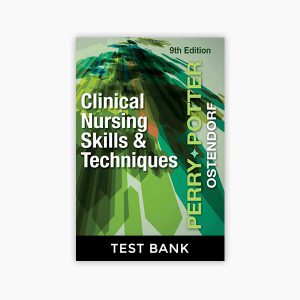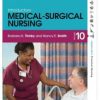Clinical Nursing Skills and Techniques 9th Edition Perry, Potter Test Bank
$35.00 Original price was: $35.00.$26.50Current price is: $26.50.
Clinical Nursing Skills and Techniques 9th Edition Perry, Potter Test Bank
Clinical Nursing Skills and Techniques 9th Edition Perry, Potter Test Bank

Description:
Chapter 01: Using Evidence in Practice
Perry et al.: Clinical Nursing Skills & Techniques, 9th Edition
MULTIPLE CHOICE
1. Evidence-based practice is a problem-solving approach to making decisions about patient care that is grounded in:
| a. | the latest information found in textbooks. |
| b. | systematically conducted research studies. |
| c. | tradition in clinical practice. |
| d. | quality improvement and risk-management data. |
ANS: B
The best evidence comes from well-designed, systematically conducted research studies described in scientific journals. Portions of a textbook often become outdated by the time it is published. Many health care settings do not have a process to help staff adopt new evidence in practice, and nurses in practice settings lack easy access to risk-management data, relying instead on tradition or convenience. Some sources of evidence do not originate from research. These include quality improvement and risk-management data; infection control data; retrospective or concurrent chart reviews; and clinicians’ expertise. Although non–research-based evidence is often very valuable, it is important that you learn to rely more on research-based evidence.
DIF: Cognitive Level: Comprehension REF: Text reference: p. 2
OBJ: Discuss the benefits of evidence-based practice.
TOP: Evidence-Based Practice KEY: Nursing Process Step: Assessment
MSC: NCLEX: Safe and Effective Care Environment (management of care)
2. When evidence-based practice is used, patient care will be:
| a. | standardized for all. |
| b. | unhampered by patient culture. |
| c. | variable according to the situation. |
| d. | safe from the hazards of critical thinking. |
ANS: C
Using your clinical expertise and considering patients’ cultures, values, and preferences ensures that you will apply available evidence in practice ethically and appropriately. Even when you use the best evidence available, application and outcomes will differ; as a nurse, you will develop critical thinking skills to determine whether evidence is relevant and appropriate.
DIF: Cognitive Level: Application REF: Text reference: p. 2
OBJ: Discuss the benefits of evidence-based practice.
TOP: Evidence-Based Practice KEY: Nursing Process Step: Assessment
MSC: NCLEX: Safe and Effective Care Environment (management of care)
3. When a PICOT question is developed, the letter that corresponds with the usual standard of care is:
| a. | P. |
| b. | I. |
| c. | C. |
| d. | O. |
ANS: C
C = Comparison of interest. What standard of care or current intervention do you usually use now in practice?
P = Patient population of interest. Identify your patient by age, gender, ethnicity, disease, or health problem.
I = Intervention of interest. What intervention (e.g., treatment, diagnostic test, and prognostic factor) do you think is worthwhile to use in practice?
O = Outcome. What result (e.g., change in patient’s behavior, physical finding, and change in patient’s perception) do you wish to achieve or observe as the result of an intervention?
DIF: Cognitive Level: Knowledge REF: Text reference: p. 3
OBJ: Develop a PICO question. TOP: PICO
KEY: Nursing Process Step: Implementation
MSC: NCLEX: Safe and Effective Care Environment (management of care)
4. A well-developed PICOT question helps the nurse:
| a. | search for evidence. |
| b. | include all five elements of the sequence. |
| c. | find as many articles as possible in a literature search. |
| d. | accept standard clinical routines. |
ANS: A
The more focused a question that you ask is, the easier it is to search for evidence in the scientific literature. A well-designed PICOT question does not have to include all five elements, nor does it have to follow the PICOT sequence. Do not be satisfied with clinical routines. Always question and use critical thinking to consider better ways to provide patient care.
DIF: Cognitive Level: Analysis REF: Text reference: p. 3
OBJ: Describe the six steps of evidence-based practice.
TOP: Evidence-Based Practice KEY: Nursing Process Step: Implementation
MSC: NCLEX: Safe and Effective Care Environment (management of care)
5. The nurse is not sure that the procedure the patient requires is the best possible for the situation. Utilizing which of the following resources would be the quickest way to review research on the topic?
| a. | CINAHL |
| b. | PubMed |
| c. | MEDLINE |
| d. | The Cochrane Database |
ANS: D
The Cochrane Community Database of Systematic Reviews is a valuable source of synthesized evidence (i.e., pre-appraised evidence). The Cochrane Database includes the full text of regularly updated systematic reviews and protocols for reviews currently happening. MEDLINE, CINAHL, and PubMed are among the most comprehensive databases and represent the scientific knowledge base of health care.
DIF: Cognitive Level: Synthesis REF: Text reference: p. 4
OBJ: Describe the six steps of evidence-based practice.
TOP: Evidence-Based Practice KEY: Nursing Process Step: Implementation
MSC: NCLEX: Safe and Effective Care Environment (management of care)
6. The nurse is getting ready to develop a plan of care for a patient who has a specific need. The best source for developing this plan of care would probably be:
| a. | The Cochrane Database. |
| b. | MEDLINE. |
| c. | NGC. |
| d. | CINAHL. |
ANS: C
The National Guidelines Clearinghouse (NGC) is a database supported by the Agency for Healthcare Research and Quality (AHRQ). It contains clinical guidelines—systematically developed statements about a plan of care for a specific set of clinical circumstances involving a specific patient population. The NGC is a valuable source when you want to develop a plan of care for a patient. The Cochrane Community Database of Systematic Reviews, MEDLINE, and CINAHL are all valuable sources of synthesized evidence (i.e., pre-appraised evidence).
DIF: Cognitive Level: Synthesis REF: Text reference: p. 4
OBJ: Describe the six steps of evidence-based practice.
TOP: Evidence-Based Practice KEY: Nursing Process Step: Implementation
MSC: NCLEX: Safe and Effective Care Environment (management of care)
7. The nurse has done a literature search and found 25 possible articles on the topic that she is studying. To determine which of those 25 best fit her inquiry, the nurse first should look at:
| a. | the abstracts. |
| b. | the literature reviews. |
| c. | the “Methods” sections. |
| d. | the narrative sections. |
ANS: A
An abstract is a brief summary of an article that quickly tells you whether the article is research based or clinically based. An abstract summarizes the purpose of the study or clinical query, the major themes or findings, and the implications for nursing practice. The literature review usually gives you a good idea of how past research led to the researcher’s question.The “Methods” or “Design” section explains how a research study is organized and conducted to answer the research question or to test the hypothesis. The narrative of a manuscript differs according to the type of evidence-based article—clinical or research.
DIF: Cognitive Level: Application REF: Text reference: p. 7
OBJ: Discuss elements to review when critiquing the scientific literature.
TOP: Randomized Controlled Trials KEY: Nursing Process Step: Implementation
MSC: NCLEX: Safe and Effective Care Environment (management of care)
8. The nurse wants to determine the effects of cardiac rehabilitation program attendance on the level of postmyocardial depression for individuals who have had a myocardial infarction. The type of study that would best capture this information would be a:
| a. | randomized controlled trial. |
| b. | qualitative study. |
| c. | case control study. |
| d. | descriptive study. |
ANS: B
Qualitative studies examine individuals’ experiences with health problems and the contexts in which these experiences occur. A qualitative study is best in this case of an individual nurse who wants to examine the effectiveness of a local program. Randomized controlled trials involve close monitoring of control groups and treatment groups to test an intervention against the usual standard of care. Case control studies typically compare one group of subjects with a certain condition against another group without the condition, to look for associations between the condition and predictor variables. Descriptive studies focus mainly on describing the concepts under study.
DIF: Cognitive Level: Synthesis REF: Text reference: p. 6
OBJ: Discuss ways to apply evidence in nursing practice.
TOP: Randomized Controlled Trials KEY: Nursing Process Step: Implementation
MSC: NCLEX: Safe and Effective Care Environment (management of care)
9. Six months after an early mobility protocol was implemented, the incidence of deep vein thrombosis in patients was decreased. This is an example of what stage in the EBP process?
| a. | Asking a clinical question |
| b. | Applying the evidence |
| c. | Evaluating the practice decision |
| d. | Communicating your results |
ANS: C
After implementing a practice change, your next step is to evaluate the effect. You do this by analyzing the outcomes data that you collected during the pilot project. Outcomes evaluation tells you whether your practice change improved conditions, created no change, or worsened conditions.
DIF: Cognitive Level: Application REF: Text reference: p. 9
OBJ: Discuss ways to apply evidence in nursing practice.
TOP: Evidence-Based Practice KEY: Nursing Process Step: Evaluation
MSC: NCLEX: Safe and Effective Care Environment (safety and infection control)
MULTIPLE RESPONSE
1. To use evidence-based practice appropriately, you need to collect the most relevant and best evidence and to critically appraise the evidence you gather. This process also includes: (Select all that apply.)
| a. | asking a clinical question. |
| b. | applying the evidence. |
| c. | evaluating the practice decision. |
| d. | communicating your results. |
ANS: A, B, C, D
EBP comprises six steps (Melnyk and Fineout-Overholt, 2010):
1. Ask a clinical question.
2. Search for the most relevant and best evidence that applies to the question.
3. Critically appraise the evidence you gather.
4. Apply or integrate evidence along with one’s clinical expertise and patient preferences and values in making a practice decision or change.
5. Evaluate the practice decision or change.
6. Communicate your results.
DIF: Cognitive Level: Analysis REF: Text reference: p. 3
OBJ: Describe the six steps of evidence-based practice.
TOP: Evidence-Based Practice KEY: Nursing Process Step: Implementation
MSC: NCLEX: Safe and Effective Care Environment (management of care)
2. In a clinical environment, evidence-based practice has the ability to improve: (Select all that apply.)
| a. | the quality of care provided. |
| b. | patient outcomes. |
| c. | clinician satisfaction. |
| d. | patients’ perceptions. |
ANS: A, B, C, D
EBP has the potential to improve the quality of care that nurses provide, patient outcomes, and clinicians’ satisfaction with their practice. Your patients expect nursing professionals to be informed and to use the safest and most appropriate interventions. Use of evidence enhances nursing, thereby improving patients’ perceptions of excellent nursing care.
DIF: Cognitive Level: Application REF: Text reference: p. 2
OBJ: Discuss the benefits of evidence-based practice.
TOP: Randomized Controlled Trials KEY: Nursing Process Step: Implementation
MSC: NCLEX: Safe and Effective Care Environment (management of care)
3. During the application stage of evidence-based practice change, it is important to consider: (Select all that apply.)
| a. | cost. |
| b. | the need for new equipment. |
| c. | management support. |
| d. | adequate staff. |
ANS: A, B, C, D
One important step for an individual or an interdisciplinary EBP committee is to consider the resources needed for a practice change project. Are added costs or new equipment involved with a practice change? Do you have adequate staff to make the practice change work as planned? Do management and medical staff support you in the change? If the barriers to practice change are excessive, adopting a practice change can be difficult, if not impossible.
DIF: Cognitive Level: Application REF: Text reference: p. 8
OBJ: Describe the six steps of evidence-based practice.
TOP: Evidence-Based Practice KEY: Nursing Process Step: Implementation
MSC: NCLEX: Safe and Effective Care Environment (management of care)
COMPLETION
1. _________________ is a guide for making accurate, timely, and appropriate clinical decisions.
ANS:
Evidence-based practice
Evidence-based practice is a guide for making accurate, timely, and appropriate clinical decisions.
DIF: Cognitive Level: Knowledge REF: Text reference: p. 2
OBJ: Define the key terms listed. TOP: Evidence-Based Practice
KEY: Nursing Process Step: Assessment
MSC: NCLEX: Safe and Effective Care Environment (management of care)
2. Evidence-based practice requires good ______________.
ANS:
nursing judgment
Evidence-based practice requires good nursing judgment; it does not consist of finding research evidence and blindly applying it.
DIF: Cognitive Level: Comprehension REF: Text reference: p. 2
OBJ: Discuss the benefits of evidence-based practice.
TOP: Evidence-Based Practice KEY: Nursing Process Step: Assessment
MSC: NCLEX: Safe and Effective Care Environment (management of care)
3. While caring for patients, the professional nurse must question ________________.
ANS:
what does not make sense
Always think about your practice when caring for patients. Question what does not make sense to you, and question what you think needs clarification.
DIF: Cognitive Level: Analysis REF: Text reference: p. 3
OBJ: Describe the six steps of evidence-based practice.
TOP: Evidence-Based Practice KEY: Nursing Process Step: Implementation
MSC: NCLEX: Safe and Effective Care Environment (management of care)
4. A systematic review explains whether the evidence that you are searching for exists and whether there is good cause to change practice. In _____________, all entries include information on systematic reviews. Individual randomized controlled trials (RCTs) are the gold standard for research.
ANS:
The Cochrane Database
A systematic review explains whether the evidence that you are searching for exists and whether there is good cause to change practice. In The Cochrane Database, all entries include information on systematic reviews. Individual randomized controlled trials (RCTs) are the gold standard for research.
DIF: Cognitive Level: Analysis REF: Text reference: p. 5
OBJ: Describe the six steps of evidence-based practice.
TOP: Evidence-Based Practice KEY: Nursing Process Step: Implementation
MSC: NCLEX: Safe and Effective Care Environment (management of care)
5. __________________ are the gold standard for research.
ANS:
Randomized controlled trials
Individual randomized controlled trials (RCTs) are the gold standard for research (Titler and others, 2001). An RCT establishes cause and effect and is excellent for testing therapies.
DIF: Cognitive Level: Knowledge REF: Text reference: p. 5
OBJ: Explain the levels of evidence in the literature.
TOP: Randomized Controlled Trials KEY: Nursing Process Step: Implementation
MSC: NCLEX: Safe and Effective Care Environment (management of care)
6. The researcher explains how to apply findings in a practice setting for the types of subjects studied in the _________________ section of a research article.
ANS:
“Clinical Implications”
Clinical Implications
A research article includes a section that explains whether the findings from the study have “clinical implications.” The researcher explains how to apply findings in a practice setting for the types of subjects studied.
DIF: Cognitive Level: Application REF: Text reference: p. 8
OBJ: Discuss elements to review when critiquing the scientific literature.
TOP: Randomized Controlled Trials KEY: Nursing Process Step: Implementation
MSC: NCLEX: Safe and Effective Care Environment (management of care)
7. ____________________ is the extent to which a study’s findings are valid, reliable, and relevant to your patient population of interest.
ANS:
Scientific rigor
Scientific rigor is the extent to which a study’s findings are valid, reliable, and relevant to your patient population of interest.
DIF: Cognitive Level: Application REF: Text reference: p. 8
OBJ: Define the key terms listed. TOP: Randomized Controlled Trials
KEY: Nursing Process Step: Implementation
MSC: NCLEX: Safe and Effective Care Environment (management of care)
8. Patient fall rates are an example of a ______________ type of study in the evidence hierarchy.
ANS:
quality improvement data
Data collected within a health care agency offer important trending information about clinical conditions and problems. Staff in the agency review the data periodically to identify problem areas and to seek solutions.
DIF: Cognitive Level: Application REF: Text reference: p. 5
OBJ: Define the key terms listed. TOP: Quality Improvement
KEY: Nursing Process Step: Implementation
MSC: NCLEX: Safe and Effective Care Environment (management of care)
Product details:
- ISBN-10 : 0323400698
- ISBN-13 : 978-0323400695
- Author: Anne Griffin Perry
Related products
Test Bank
Test Bank for Essentials of Business Law and the Legal Environment, 11th Edition: Richard A. Mann
Test Bank
Test Bank for Decision Support and Business Intelligence Systems, 9th Edition: Efraim Turban












